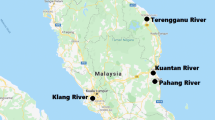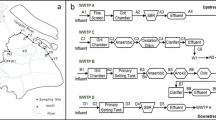Abstract
Background on the generation of the problems of endocrine disrupting pesticides (EDPs) in aquatic environment, characteristics of EDPs, adverse effects and their effect mechanism of EDPs on human and wildlife, the transportation and degradation pathways of EDPs in water and analysis methods of EDPs in water were reviewed. The importance of EDPs in water should be attached to adverse effects on wildlife and human health. It was advised to establish research programs on EDPs in aquatic environment especially in water supply source.
Similar content being viewed by others
References
Colborn, T., Dumanoski, D., Myers, J. P., Our Stolen Future: Are We Threatening Our Fertility, Intelligence, and Surival? Scientific Detective Story, New York: Dutton Books, 1996, 3.
The Institute of World Resources, United Nations Environment Program, United Nations Development Program et al., World Resource Resport-Environmental Changes and Human Health (1998–1999), Beijing: China Environmental Science Press, 1999, 3.
Colborn, T., Endocrine disruption from environmental toxicant, in Environmental and Occupational Medicine (ed. Rom, W. N.), 3rd ed., Philadelphia: Lippincott-Raven Publishers, 1998, 5.
State Environmental Protection Agency (SEPA), Department of Policy and Code, A Collection of Agreements on International Environment Concluded and Subscribed by China, Beijing: Academe Press, 1999, 5–19, 20–26.
State Environmental Protection Agency (SEPA), Department of International Cooperation, Annual Documents on Green Globe (1999–2000) (in Chinese), Beijing: China Environmental Sciences Press, 2001, 102–117.
Song, H. Y., Wang, J., Environmental endocrine-disrupting chemicals and pesticides (in Chinese), Pesticide Science and Management, 2001, 22(2): 23–25.
Ma, C. C., Gu, Z. R., Pollution of chemical pesticides with environmental hormone and monitoring and controlling (reviews) (in Chinese), Journal of Shanghai Agriculture, 2003, 19(4): 98–103.
Kavlock, R. J., Daston, G. P., Derosa, C. et al., Research needs for the risk assessment of health and environmental effects of endocrine disrupters: a report of the US EPA-sponsored workshop, Environ. Health Perspect., 1996, 104(suppl. 4): 715–740.
Callahan, M. A., Slimak, M. W., Gabel, N. W. et al., Water-Related Environmental Fate of 129 Priority Pollutants. Volume II. EPA-440/4-79-029b, Washington DC: U.S. Environmental Protection Agency, December 1979, 49–57.
Chapman, P. M., McDonald, B. G., Lawrence, G. S., Weight-of-Evidence Issues and Frameworks for Sediment Quality (and Other) Assessments, Human and Ecological Risk Assessment, 2002, 8(7): 1489–1515.
Nhan, D. D., Am, N. M., Carvalho, F. P. et al., Organochlorine pesticides and PCBs along the coast of north Vietnam, Sci. Total Environ., 1999, 237/238: 363–371.
Khim, J. S., Kannan, K., Villeneuve, D. L. et al., Characterization and distribution of trace organic contaminants in sediment from Masan Bay, Korea. 1. Instrumental Analysis, Environ. Sci. Technol., 1999, 33: 4199–4205.
Bakan, G., Ariman, S., Persistent organochlorine residues in sediments along the coast of mid-Black Sea region of Turkey, Mar. Pollut. Bull., 2004, 48: 1031–1039.
Richardson, B. J., Zheng, G. J., Chlorinated hydrocarbon contaminants in Hong Kong surficial sediments, Chemosphere, 1999, 39: 913–923.
Doong, R. A., Peng, C. K., Sun, Y. C. et al., Composition and distribution of organochlorine pesticide residues in surface sediments from the Wu-Shi River estuary, Taiwan, Mar. Pollut. Bull., 2002, 45: 246–253.
Wang, X. T., Chu, S. G., Xu, X. B., Organochlorine pesticide residues in water from Guanting Reservoir and Yongding River, China, Bull. Environ. Contam. Toxicol., 2003, 70: 351–358.
Zhou, W. M., Fu, D. Q., Sun, Z. G., Priority black list of pollutants in water established in China (in Chinese), Environmental Science Resarch, 1991, 4: 912–915.
Colborn, T., Vomsaal, F. S., Soto, A. M., Developmental effects of endocrine disruption chemicals in wildlife and humans, Environ. Health Perspect, 1993, 101(4): 378–384.
Safe, S. H., Environmental and dietary estrogen and human health: Is there a problem? Environ. Health Perspect, 1995, 103(4): 343–351.
Crisp, T. M., Clegg, E. D., Cooper, R. L. et al., Environmental endocrine disruption: An effect assessment and analysis, Environ. Health Perspect, 1998, 106(Suppl 1): 11–56.
Arnold, S. F., Klotz, D. M., Collins, B. M. et al., Synergistic activation of estrogen receptor with combinations of environmental chemicals, Science, 1996, 272: 1489–1492.
Gilbertson, M., Linking water quality to wildlife and human health, focus, International Joint Commission, November 1998, 18–19.
Chance, G. W., Harmsen, E., Children Are Different: Environmental Contaminants and Child Health. Canadian Public Health Review, Vol. 89, Supplement 1, May/June 1998, 10–14.
Pernille, A., Grandjean, P., Jorgensen, T. et al., Hartvig, Organochlorine exposure and risk of breast cancer, Lancet, 352(9143), 1998, 1816–1820.
Warren, N., Allana, I. J., Carter, J. E. et al., Pesticides and other micro-organic contaminants in freshwater sedimentary environments-a review, Applied Geochemistry, 2003, 18: 159–194.
Wania, F., Mackag, D., Tracking the distribution of persistent organic pollutants, Environ. Sci. Technol., 1996, 30: 390A.
Carsel, R. F., Mulkey, L., The pesticide root zone mode (PRZM): a procedure for evaluating pesticide Lashing treats to groundwater, Ecological Modeling, 1985, 30: 49–69.
Ewald, G., Larsson, P., Linge, H. et al., Biotransport of organic pollutants to an island Alska Lake by migrating sockeye salmon (Onchorhynchus nerka), Arctic, 1998, 51(1): 40–47.
Ou, X. M., Wang, X. G., Huang, D. F. et al., Progress in studies on pesticide degradation by bacterium (in Chinese), World Pesticides, 2003, 25(6): 30–35.
Li, G. Y., Tan, R. S., The relationship of environmental endocrine-disrupting chemicals and people health (in Chinese), Overseas Iatrology and Hygienics Fascicule, 2001, 28(4): 193–196.
Boul, H. L., Cambarn, M. L., Hucker, D. et al., Influence of Agricultural Practices on the Levels of DDT and Its Residues in Soil, Environ. Sci. Technol., 1994, 28: 1397–1402.
Sayler, C. S., Hooper, S. W., Layton, A. C. et al., Catabolic plasmids of environmental and ecological significance: A review, Microbial Ecology, 1990, 19: 1–20.
Tomlin, C. D. S., The Pesticide Manual: A World Compendium, Farnham: British Crop Protection Council, 2000, 11–19.
Song, X. J., Technological prevention and cure measures of point pollution resources of pesticides and chemical fertilizer in Beijing (in Chinese), Environment Protection, 2000, (9): 30–32.
Leistra, M., Smelt, J. H., An appraisal of methods for measurement of pesticide transformation in the groundwater zone, Pesticide Management Science, 2001, 57 (4): 333–345.
Ren, J., Jiang, K., Progress in studies on environmental endocrine-disrupting chemicals (in Chinese), Chemistry Progress, 2001, 13(2): 135–142.
Castillo, L. E., Ruepert, C., Solis, E., Pesticide residues in the aquatic environment of banana plantation areas in the North Atlantic Zone of Costa Rica, Environ. Toxicol. Chem., 2000, 19: 1942–1950.
Nogueira, J. M. F., Sandra, T., Sandra, P., Multiresidue screening of neutral pesticides in water samples by high performance liquid chromatography-electrospray mass spectrometry, Analytica Chimica Acta, 2004, 502(2): 209–215.
Ying, G. S., Analysis methods of foreign origin estrogen (in Chinese), Overseas Iatrology and Hygienics Fascicule, 1995, 22(4): 216–220.
Colborn, T., Smolen, M. J., Epidemiological analysis of persistent organochlorine contaminations in cetaceans, Rev. Environ. Contam. Toxicol., 1996, 146: 91–172.
Volker, L., Wulf, A., Alicio, A. P. et al., Pesticides in surface water, sediment, and rainfall of the northeastern Pantanal Basin, Brazil. J. Environ. Qual., 2002, 31(5): 1636–1648.
Zhang, Z. L., Hong, H. S., Wang, X. H. et al., Determination and load of Organophosphorus and Organochlorine pesticides at water from Jiulong River Estuary, China Mar. Pollut. Bullet., 2002, 45(12): 397–402.
Bakan, G., Ariman, S., Persistent organochlorine residues in sediments along the coast of mid-Black Sea region of Turkey, Mar. Pollut. Bullet, 2004, 48: 1031–1039.
Chau, A. S. Y., Afgan, B. K., Analysis of Pesticides in Water, Vol. 1: Significance, Principles, Techniques and Chemistry of Pesticides. Vol. 2: Chlorine and Phosphorus-Containing Pesticides, Boca Raton, FL: CRC Press Inc., 1982, 91–113, 238.
Castilho, J. A., Fenzl, N., Guillen, S. M. et al., Organochlorine and organophosphorus pesticide residues in the Atoya river basin, Chinandega, Nicaragua. Environ. Pollut., 2000, 110: 523–533.
Author information
Authors and Affiliations
Corresponding author
About this article
Cite this article
Xue, N., Wang, H. & Xu, X. Progress in study on endocrine disrupting pesticides (EDPs) in aquatic environment. Chin.Sci.Bull. 50, 2257–2266 (2005). https://doi.org/10.1007/BF03183731
Received:
Accepted:
Issue Date:
DOI: https://doi.org/10.1007/BF03183731




